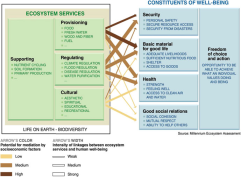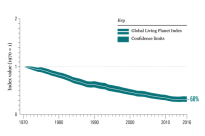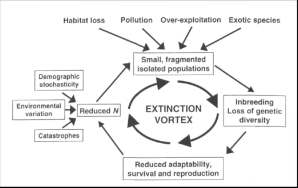Planetary boundary 2: Biodiversity and conservation issues
Objectives
Understand the issues linked to the erosion of biodiversity and what are the means implemented to preserve it.
Introduction
What is biodiversity ?
Biodiversity is the contraction of the words “diversity” and “biological”.
It therefore designates both all living beings as well as the diversity of the natural environments in which they live (= ecosystems).
The animal and plant biodiversity of an ecosystem therefore corresponds to the diversity of species present in this environment.
The biodiversity of ecosystems is the diversity of natural environments (forest, meadows, deserts, etc.).
Why preserve biodiversity?
3 fundamental reasons
For its intrinsic value (it participates in the evolutionary history created more than 2 billion years ago)
For its evolutionary potential, it has the ability to adapt to current global changes.
For functionalities linked to ecosystems essential to human societies, also called ecosystem services. Indeed, the proper functioning of ecosystems depends on maintaining biodiversity.
What part of the biodiversity do we want to preserve?
Threatened Species: Conservation ecology and restoration (eg creation of protected areas) are used to protect rare or endangered species.
Ordinary biodiversity: the one that surrounds us (present in 80% of ecosystems)
The genetic diversity of domesticated species
Biodiversity and ecosystem services
Ecosystem service: Service that ecosystems (and biodiversity) provide to humans.
Biodiversity and the ecosystems in which it is expressed provide many of the goods and services that support human life: food, fuel and building materials; purification of air and water; stabilization and moderation of the planet's climate; moderation of floods, droughts, temperature extremes and wind forces; the generation and renewal of soil fertility; the maintenance of genetic resources that contribute to crop variety and the selection of animals, medicines, and other products; and cultural, recreational and aesthetic benefits.
The Millennium Ecosystem Assessment carried out in 2005 standardized this notion of ecosystem service and defined 24 main social and environmental issues.

Biodiversity preservation issues
General finding
Biodiversity is deteriorating around the world, in fact 75% of terrestrial environments and 40% of marine ecosystems are severely degraded: this is the alarming observation shared by international experts. One million species are threatened with extinction around the world. The rate of disappearance is 100 to 1000 times greater than the natural rate of extinction: we are talking about a sixth mass extinction of species. This degradation of biodiversity is largely the consequence of our human activities, which exert major pressures on nature.
WWF and the London Zoologic Society have produced a Living Planet Index. This index is based on the study of 10,000 populations of 3,000 vertebrate species distributed around the world. This index shows that the average abundance of these populations has declined by 68% since 1970. This leads to the so-called extinction vortex (see figure 3).
Natural environments are also weakened: more than 35% of coastal and continental wetlands have disappeared since 1970 in the world and tropical forests could disappear within 50 to 70 years at the current rate of deforestation.



The causes of the biodiversity erosion
Certain natural causes may explain the disappearance of species or natural environments, but the current rate of erosion is largely attributable to human activities:
The transformation of habitats: Some natural habitats rich in biodiversity are artificialized. For example the transformation of forests into agricultural ecosystems. The destruction and fragmentation of the related natural environments is due in particular to urbanization and the development of transport infrastructure;
Overexploitation of wild species: overfishing, deforestation, poaching, etc. ;
Eco-toxicity: pollution of water, soil and air by pesticides or other toxic products for the environment;
Biological invasion: This is the introduction of invasive alien species supplanting native species.
Climate change which can add to and worsen other causes. It helps to modify the living conditions of species, forcing them to migrate or to adapt their way of life;
Measures taken against these threats:
Measures against habitat transformation: Ecological Compensation. Each time a human infrastructure is put in place, it will be necessary to either avoid the destruction of natural environments or to compensate for the impact by restoring other ecosystems.
Solve the problem of open access: There is no restriction on access to common resources, so the solution would be to regulate access to common resources.
Evaluate the toxicity of products using participatory science: observers will assess the state of biodiversity in all areas in order to understand the impact of a given product on a given environment by comparing it to other environments in which it is product is not present.
Nature-based solutions: Managing ecosystems through biodiversity, for example by reintroducing species that regulate the environment.
Payments for services rendered to nature: remunerate farmers to maintain the functionality of ecosystems (by limiting the use of pesticides and intensive agriculture in favor of more sustainable and environmentally friendly methods).
Link between climate and biodiversity
Biodiversity plays a fundamental role in regulating the climate. Indeed, forests, wetlands and oceans have the ability to store atmospheric carbon, and thus help to mitigate global warming. On the other hand, it also helps to mitigate the effects of global changes, for example by protecting the coastline from erosion or by reducing the intensity of floods and floods.
Conversely, current climate change is modifying the interactions between species and their living environments in ecosystems. For a global warming of 2 to 3 ° C, experts predict an increase in the risk of disappearance for 20 to 30% of animal and plant species.
Examples of climate impacts on biodiversity
The rise in temperatures reduces climatic harshness, lengthens the vegetation periods and modifies the behavior of migrants populations. For example, the flowering and harvest dates for fruit trees and vines are advanced which can disrupt the synchronizations between the reproductive period of species and the seasonal development of the plants on which they feed.
Rising water temperatures are changing the distribution of fish populations.
Ocean acidification, linked to the absorption of atmospheric carbon, is damaging to the construction and survival of coral reefs, as well as to all marine organisms with calcareous shells.
Conservation of biodiversity in France
Issues related to agriculture
Ecosystems provide two types of services related to agriculture:
Provisioning services: production of food and other goods.
Regulation services: Pollination is a central mechanism in the regulation of crops, in fact 90% of plant species are pollinated. The disappearance of pollinating insects thus leads to the disappearance of a large number of plant species and presents a major stake for agriculture. Another example is biological control: birds, bats (bats) and parasitic insects are carnivorous species which allow the regulation of pest species in crops.
In recent decades, the improvement of supply services (intensive production) has led to a degradation of regulatory services (disappearance of key species). However, if the degradation of regulatory services in turn leads to the degradation of supply services. One solution would therefore be to moderate agricultural production in order to ensure the proper functioning of ecosystem services in the long term.
Biodiversity plan
Announced in 2018, the Biodiversity Plan is oriented around five main issues to preserve environments, protect ecosystems and endangered species, allow the transition of production and consumption models, take into account the link between health and the environment and preserve the sea. and the coastline.
National strategy for protected areas
Adopted in January 2021, this national strategy for protected areas 2030 aims to protect, from 2022, 30% of the national territory and maritime areas, of which a third under strong protection.
Find out more : ecologie.gouv.fr/aires-protegees-en-france
SNDI
Launched in 2018, the National Strategy to Combat Imported Deforestation (SNDI) aims to put an end by 2030 to deforestation caused by French imports of unsustainable forest or agricultural products such as soybeans, palm oil, beef, cocoa, rubber and wood.